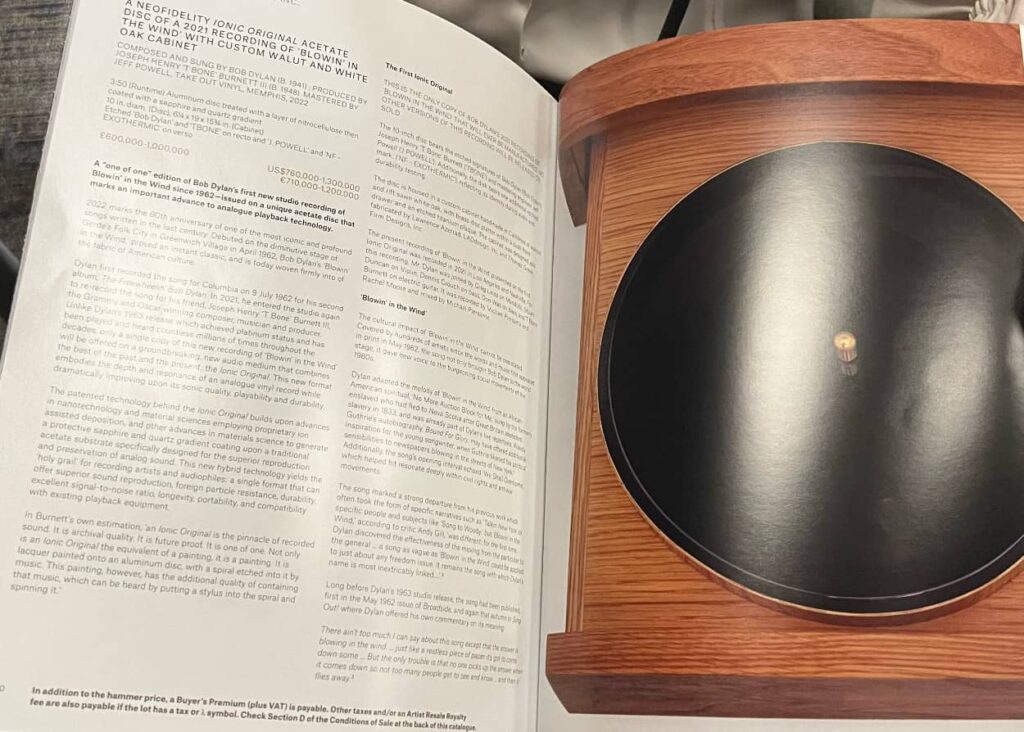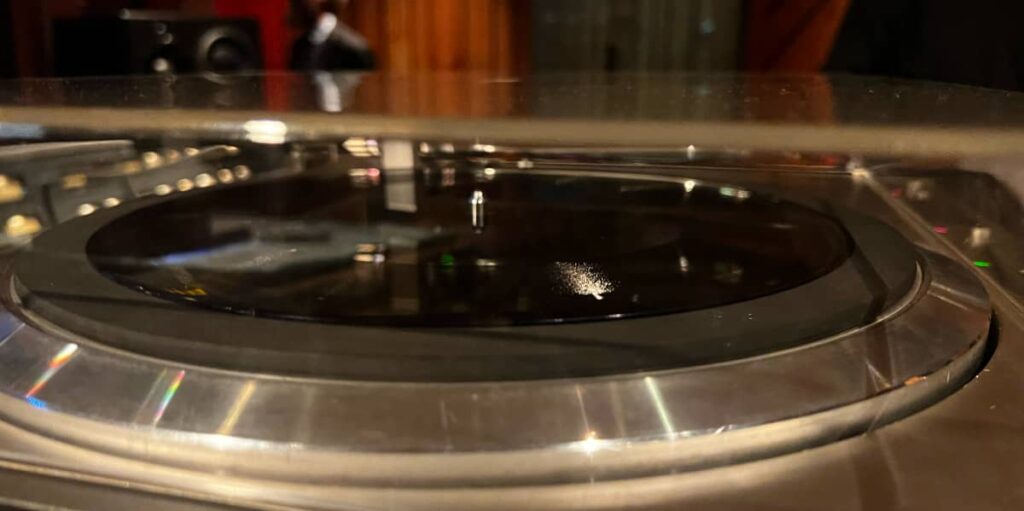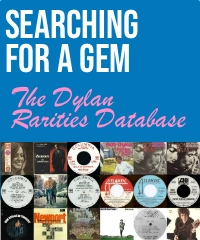<< Back to Blog
T-Bone Burnett’s Ionic Original Technology and Dylan’s New Blowin’ In The Wind (Pt.2)
This is part II in our II part series on T-Bone Burnett’s new Ionic Originals. Part I discussed the recording and performance, here in Part II we discuss the recording session and the technology. Part III covers business issues including price and scarcity.
]Since T-Bone Burnett announced that Bob Dylan had re-recorded Blowin’ In The Wind for release on the new Ionic Original technology, attention has been split (not always evenly) among three key issues:
- Bob Dylan is recording new versions of old songs.
- T-Bone has developed new technology to improve the quality of records.
- This is a ‘one-of-one’ recording which is going to be auctioned off, hopefully for millions of dollars, and nobody else gets to hear it.
Each of these deserves independent examination, but unfortunately most of the reporting and discussions has been convoluted and confused. Two other adjacencies made it worse: the recent Shadow Kingdom recordings and then the Columbia Records announcement of a new 60th anniversary video.
Let’s dispense with these two first:
- SHADOW KINGDOM
The Ionic recording sessions were not the same as the Shadow Kingdom recording sessions. More on the Ionic sessions below. They both just happen to be pandemic-era new Dylan recording sessions. - COLUMBIA RECORDS
The new video (at first a ‘secret’ new something) was announced the same week as the Ionic announcement but a we now know had nothing at all to do with these recordings or their release in any way.
In Part I of this series I talked about the sound and performance of the new Blowin’ In The Wind recording. In this Part II I’m going to discuss the new recording session itself, and then the technology that Ionic is releasing. In the interest of time (yours and mine) the pricing and the business model will be saved for a future Part III to conclude this series.

THE NEW RECORDINGS
At the NYC event, T-Bone revealed that these were dedicated sessions for the purposes of these Ionic releases. These tracks did not come from the Shadow Kingdom sessions. They recorded a number of songs although T-Bone declined to reveal exactly how many or to name the other titles. These others are intended for future ‘one-of-one’ releases, but it sounds like everything after Blowin’ In The Wind is on hold (or at least top secret) until they successfully sell this one.
The band for the BITW recording and perhaps the others includes:
- T-Bone Burnett on electric guitar
- Greg Liesz on Mandolin
- Dennis Crouch on string bass
- Don Was on bass
- Stuart Duncan plays violin
Anything Bob Dylan records is a big deal, and as we now know even the outtakes and session tapes eventually become successful commercial releases. Dylan re-recording old material has been done only rarely before Shadow Kingdom, so that adds further interest and intrigue. In this case, Dylan clearly wanted to support the technology, and was at least supportive of the business model.
I still see some ambiguity (but not much) about whether or not this recording will or may ever be released in any other format. Most of T-Bone’s language conflates the recording with the record (acetate) and one could come to believe that allowing others to hear the recording wouldn’t change the value or uniqueness of the physical object. But listening to the words and tone in which he talked about this at the event, it sounded like there would be no other releases ever. “This isn’t for Bob’s fans” he said before continuing “well, it’s for one fan.”
He did clarify that Columbia records holds the copyright (Dylan assigned it) and the purchaser gets no such rights; the sale of a painting was made as an analogy by the Christie’s representative. But a painting owner can show it to others even if they can’t license prints and t-shirts. So will the owner be restricted from ‘playing it’ in a way that others can hear – obviously not. What happens if they do so and someone captures a recording and shares it online? Probably nothing because it’s somewhat inevitable (depending on who buys it and how they behave.)
It would be nice to hear T-Bone definitively state that there will be no future releases of these recordings on any other (lessor) media, or clarify that it may be possible at some time in the future. And to tell us how they will feel/react if the owner makes if available even if it’s not ‘for sale’.

THE TECHNOLOGY – SIMPLE VERSION
Before I try to go deep, here is the simple version: Ionic’s technology has two key virtues: it delivers recorded music at the quality of the acetate which is many generations younger than any LP (and therefore produces vastly better sound than any LP), and the discs themselves don’t scratch, decay, or attract dust, and therefore keep sounding great without the massive hassle that is necessary to keep vinyl in good shape.
In other words: these discs are better than vinyl and they stay that way.
T-Bone is credible and highly respected, has good intentions and deserves benefit of the doubt in his capabilities to execute. If he succeeds recorded music is better, easier, and artists can make more money (see business model section and don’t yet whine about the cost). I’m pulling for him.
THE TECHNOLOGY – NOT THE SIMPLE VERSION
The technology in Ionic Originals has been covered particularly poorly in the press. None of them took the time to explain either the problem Ionic is addressing or how they are solving it.
T-Bone described the problem succinctly: “When you record to tape” he said, “and then cut an acetate it sounds harder, tougher, and bigger. (The final) vinyl never sounds as good as the acetate did – all artists say that.” He went on to explain how acetates become records and in some cases there are 3 to 5 stages or steps, each of which is in some way a ‘generation’ and therefore degrades the sound.
If all Ionic was doing was cutting generations out of the process it would be a breakthrough, but they’re doing much more than that.
The good thing about acetates, he explained, is that they’re made of microcellulos (much like nail polish) which is easy for the lathe to ‘cut’ and delivers a fine surface with a low drag coefficient so they play quieter than vinyl (less surface noise). The problem is that gravity on the needle creates friction, and that causes heat, and together they quickly degrade the relatively soft material. You can only play an acetate a few times before It’s done.
The question T-Bone asked was: have there been scientific advancements that can be used to keep the good aspects of acetate while eliminating the bad? What he found (with some help from Georgia Tech) was something he called Ionic Deposition, which he described as a ‘diamond like coating’ that could be applied to an acetate to reduce friction, thereby protecting the surface from heat, and allowing it to be played 1000’s of times without degradation.
They also found the coating reduces static electricity (and ionization I presume) which stops the discs from attracting dust the way vinyl does – which is why serious vinyl addicts have ZeroStat guns or other products which fight but often don’t cure this problem.
Today’s vinyl also requires serious effort to clean/wash (for maximum fidelity) with ultrasonic baths and other laborious, time consuming, and expensive methods. T-Bone claimed that with Ionics “if any dust does land in the groove, the needle cleans it” and that records “get cleaner as you play them” which he said was totally unexpected. This sounds slightly fantastical, but may be true.
With vinyl, dust can be embedded into the soft vinyl by playing a record that hasn’t been fully and properly cleaned, scaring it forever. If the Ionic surface is extremely hard (it is) one could imagine dust getting pushed forward instead of driven in. It will be interesting to see how the claim holds up and what cleaning and care is recommended for Ionic Originals.
Another issue T-Bone addressed was surface noise. The coating on the Ionics allows the needle to run with less friction and drag, and therefore it generates less inherent surface noice both on run in and run out of the record as well as underneath the music itself. While the best vinyl today has sonic benefits vs digital (to many ears in many cases anyway) what digital provides is a silent sonic floor. Bringing that to vinyl (acetate) creates a ‘best of both worlds’ situation.
So the promise is a vinyl like record made with less generation loss in the process, on a media that avoids static and pops (not entirely but largely), doesn’t need insane cleaning effort, and has noise floor near zero. In other words, it promises to fix every single significant problem vinyl has, except cost (we’ll get to that) and the fact that they’re made of petroleum-based materials (beyond the scope of this discussion but on a global scale a minor point.)
Plus they they can be played on any existing turntable and with any stylus. This fact is extremely important and impressive.
THIS RECORDING
One important point (added after publication because I forgot to include it): They recorded to tape and digital, but when they transferred the tape to acetate it brought the hiss, which was no longer covered by floor noise, so they mastered from the digital recording to the acetate.
MORE NEXT TIME

Craig Danuloff
Craig is the founder of Freak Music Club. He is a technology entrepreneur, a one-time concert photographer, and avid audiophile. Currently residing in New York City.
The FM Podcast Network Shows
- Dylan.FM
- The Dylantantes
- Infinity Goes Up On Trial
- Watching The Covers Flow
- Pod Dylan
- The Bob Dylan Primer


